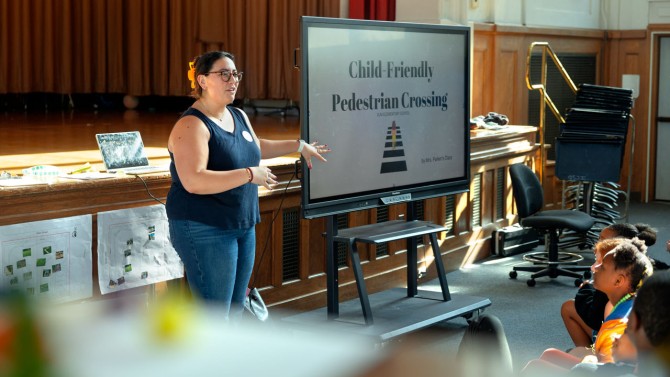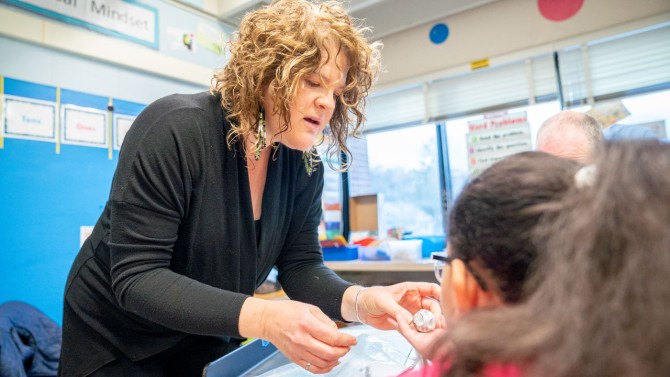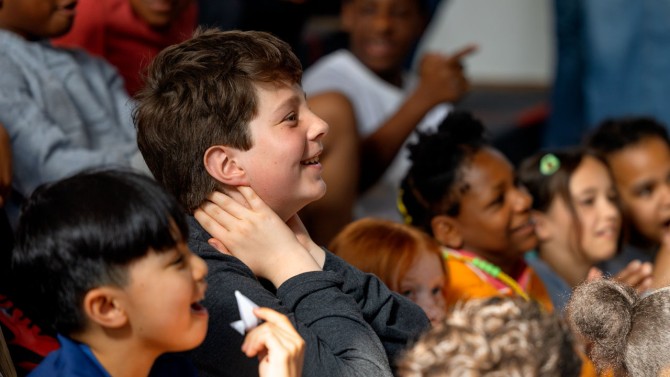
Beverly J. Martin Elementary students explore model play spaces created by their peers, with reading teacher Jenna Hallas, on May 8.
Cornell experts, Ithaca elementary students re-imagine outdoor spaces together
By Caitlin Hayes, Cornell Chronicle
On a recent spring day, the fourth grade students at Ithaca’s Beverly J. Martin Elementary School took the stage to share their dreams for a new outdoor play space.
They discussed a climbing wall and obstacle course, a garden, a koi pond, a volcano structure they could climb in and out of. They wanted a communication board for kids who struggle with language and a bright crosswalk or bridge to keep students safe on their way to the play space across West Court Street. They debated the strengths and weaknesses of mud. They wanted kids to feel “happy and frightened,” to have areas where they could be challenged and where they could be calm.
The presentations were part of an ongoing collaboration between the Ithaca City School District and Janet Loebach, the Evalyn Edwards Milman Assistant Professor in Child Development in the College of Human Ecology, to center student voices in the design and planning of their playgrounds and outdoor spaces.
“If it’s a kid space, we want to have kid voices. We want to think about our students as our partners and leaders,” said Amanda Verba ’97, chief operations officer for the school district. “That has been one of our priorities as a district, and this project takes it to another level.”
Since fall 2023, Loebach and her students have been working with classes at Fall Creek Elementary School and Beverly J. Martin (BJM) to assess their current spaces and re-envision their outdoor spaces, which the district has flagged for replacement and renovation. Loebach is now distilling the student designs and priorities for Tetra Tech architects, who will incorporate them into the final plans. The district estimates that the renovation at Fall Creek will begin in 2026, with BJM following.
In June, Loebach, who works with young people to co-design youth-friendly environments and studies how those spaces impact children’s play, well-being and development, will return to Fall Creek with Tetra Tech to show students how their ideas have been honored in the proposed playground renovation design. Those plans will also be the subject of a forum for the Fall Creek community on June 10 at 7 p.m. at the school.
“The experience of engaging the students in this visioning can be incredible in and of itself, with big gains in many developmental areas,” Loebach said. “If you give kids the right tools and the time, they’re quite savvy designers – they know what they want and need. When they understand that their ideas are going to be taken seriously, they move past the ‘big in-ground swimming pool’ or ‘cotton candy machine’ ideas and come to really feasible and well-thought-out ideas.”
The students say including them in the process is also common sense. “If you don’t ask the kids, they might not like the playground you build,” said BJM fourth grader Calvin Kinkhabwala, “and it’s just going to be a huge waste.”
A golden opportunity
The collaboration between Loebach and the school district began shortly after the district found that the Fall Creek playground – featuring a beloved wooden castle-like structure – was nearing the end of its life. The district knew the Fall Creek community, as well as the broader Ithaca community, would grieve the loss of the iconic structure, which was designed by local architect Bob Leathers of Leathers Playgrounds and built by the community in 2001.
“There’s a lot of history around who built it and a lot of people, a lot of parents, with very fond memories,” Verba said.
The district wanted the process of replacing the playground to be community-oriented, with students leading the conversation, Verba said. They connected with Loebach, who emphasized the opportunity the district had to create outdoor spaces that support not just play but also children's mental health and well-being.
“It’s really one of the biggest assets that schools have, and schools in general chronically under-utilize and under-invest in it,” Loebach said. “And this planned renovation is a golden opportunity to engage students in visioning this space and for the school district to really walk the talk of centering student voices.”
Undergrad and graduate students in Loebach’s DECA Lab (Design Environments with|for Children & Adolescents), and in her course Designing Age Friendly Environments, worked with Fall Creek’s fifth grade classes last fall, conducting an 11-week program with one class and a three-week program with the other. They met with BJM’s fourth grade classes this spring in an eight-week program. The Cornell student facilitators helped lead students in various evaluation and design activities, including hands-on assessments of their current spaces, identifying what they like and don’t like, how they use the space and what experiences it provides them (or not).
In another activity, Fall Creek and BJM students reviewed photographs of playgrounds from Ithaca and around the world, identifying their favorite structures and designs and the play experiences that were most important to them. In each program, students worked in small design teams to map out what they wanted their spaces to look like and the play features and experiences they most desired, and presented their designs to their peers, school board members and district staff.
“We’re very transparent with the kids during these programs,” Loebach said. “We tell them that the final design will not look just like their imagined design, but it will incorporate the play experiences they indicated were most important to them. We manage expectations in that sense while still honoring their ideas and priorities.”
Verba said the learning gains from the project are many: understanding the elements of project design, developing empathy and collaboration skills, gaining exposure to multiple career paths, learning strategies to document and map thinking as well as tools to identify what’s valuable and what’s not.
During the presentation of their designs, the Fall Creek students wowed their adult audience by bringing up questions of financial and practical feasibility of their peers’ designs (for example, of integrating a water slide). And, without prompting, student groups consistently made inclusion a priority: they wanted the playground to be accessible for those with disabilities and considered the needs of both younger and older kids.
“I was impressed and pleased with how they wanted to make sure the playground could be enjoyed by everyone,” said Chris Bell, a fifth-grade teacher at Fall Creek. “They sort of overcame a hurdle in the beginning, too, that since they’re fifth graders, they’re designing this thing that they’re not going to be here to enjoy. In the end they were still excited to offer suggestions and possibilities for what could be enjoyable for the future, for the next group.”
Xavier Brangman, a fourth grader at BJM, said, “It was very active, it was fun, and I got to use my brain.”
For the school district, the projects have provided a model for incorporating student voices, one they plan to use in all future planning and design initiatives.
“This is now the standard for how we look at our elementary, middle and high school spaces, by grounding student voices in design,” Verba said.
An expanded landscape
As the project progresses – with the district already committed to renovating the playground of at least one more elementary school – Loebach and her students will track how the new outdoor spaces affect kids’ play and social behaviors, sense of belonging and well-being.
“The research to understand the impacts of these changes is so rare, as these opportunities come up so infrequently,” Loebach said. “We want to look at the impacts on children’s play, their interactions, and more broadly, how does including students in the visioning process impact what we call ‘positive youth development outcomes?’”
In the shorter term, Loebach is documenting best practices for co-designing with students. She’ll compare the 11-week engagement to the three-week engagement, for example, to understand whether the longer program allowed kids to generate more complex, sophisticated and applicable ideas. From these inquiries, Loebach and students are developing a Co-Design Playbook that designers and schools can use for their own student-centered design projects.
Loebach’s group has also distilled the plans from Fall Creek students into a design brief for Tetra Tech, which is being used to develop the proposed renovation plan, and will do the same with BJM’s student designs. Loebach is also applying for external funding to continue the research and collaboration.
“At Cornell, my engagement with the community is valued, so I can center it in my work and integrate it with my research and my teaching, and not have the engagement part off the side of my desk, so to speak,” Loebach said.
Verba said the project has enhanced and expanded the landscape of Cornell outreach to district buildings. “Sometimes it can feel like there’s a separation between Cornell and the community. But there is a fluidity, because our community is your community and vice versa. This is one of those projects that drives home that connection, and we look forward to seeing our partnership continue to grow.”
Media Contact
Get Cornell news delivered right to your inbox.
Subscribe



